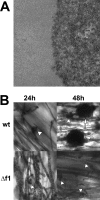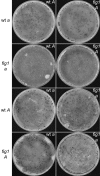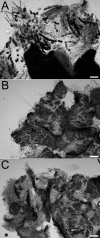Role of Fig1, a component of the low-affinity calcium uptake system, in growth and sexual development of filamentous fungi
- PMID: 22635922
- PMCID: PMC3416067
- DOI: 10.1128/EC.00007-12
Role of Fig1, a component of the low-affinity calcium uptake system, in growth and sexual development of filamentous fungi
Abstract
The function of Fig1, a transmembrane protein of the low-affinity calcium uptake system (LACS) in fungi, was examined for its role in the growth and development of the plant pathogen Fusarium graminearum. The Δfig1 mutants failed to produce mature perithecia, and sexual development was halted prior to the formation of perithecium initials. The loss of Fig1 function also resulted in a reduced vegetative growth rate. Macroconidium production was reduced 70-fold in the Δfig1 mutants compared to the wild type. The function of the high-affinity calcium uptake system (HACS), comprised of the Ca(2+) channels Mid1 and Cch1, was previously characterized for F. graminearum. To better understand the roles of the LACS and the HACS, Δfig1 Δmid1, Δfig1 Δcch1, and Δfig1 Δmid1 Δcch1 double and triple mutants were generated, and the phenotypes of these mutants were more severe than those of the Δfig1 mutants. Pathogenicity on wheat was unaffected for the Δfig1 mutants, but the Δfig1 Δmid1, Δfig1 Δcch1, and Δfig1 Δmid1 Δcch1 mutants, lacking both LACS and HACS functions, had reduced pathogenicity. Additionally, Δfig1 mutants of Neurospora crassa were examined and did not affect filamentous growth or female fertility in a Δfig1 mating type A strain, but the Δfig1 mating type a strain failed to produce fertile fruiting bodies. These results are the first report of Fig1 function in filamentous ascomycetes and expand its role to include complex fruiting body and ascus development.
Figures







References
-
- Abràmoff MD, Magalhães PJ, Ram SJ. 2004. Image processing with ImageJ. Biophotonics Int. 11: 36–42
-
- Beckett A, Crawford RM. 1973. The development and fine structure of the ascus apex and its role during spore discharge in Xylaria longipes. New Phytol. 72: 357–369
-
- Berridge MJ, Bootman MD, Roderick HL. 2003. Calcium signalling: dynamics, homeostasis and remodelling. Nat. Rev. Mol. Cell Biol. 4: 517–529 - PubMed
-
- Booth C. 1971. The genus Fusarium. Commonwealth Mycological Institute, Kew, Surrey, England
Publication types
MeSH terms
Substances
LinkOut - more resources
Full Text Sources
Other Literature Sources
Miscellaneous

